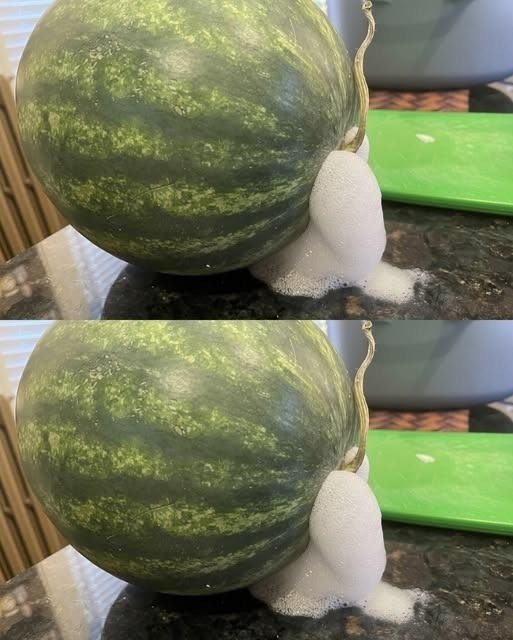ADVERTISEMENT
3. Discoloration of the Flesh
Another sign that your watermelon may be past its prime is if the flesh starts to show unusual discoloration. Fresh watermelon should have a vibrant red or pink color. If you notice patches of brown, yellow, or gray in the flesh, it’s a sign of spoilage. This discoloration could be due to over-ripeness, bacterial growth, or the beginning stages of mold development.
Why You Should Avoid Eating It: Discoloration is often a sign that the watermelon has undergone internal changes that affect its safety and taste. It could be an indication of mold or bacterial contamination that could lead to foodborne illnesses.
4. Excessive Liquid Leaking from the Watermelon
While it’s normal for watermelons to have a lot of moisture, if you notice that the fruit is leaking excessive amounts of liquid, that could be a sign of spoilage. If the watermelon is cut and sitting out for too long, or if it has been improperly stored, the liquid inside may begin to escape, leaving the fruit looking shriveled or empty.
Why You Should Avoid Eating It: Leaking liquid could indicate that the watermelon’s interior is breaking down, and bacteria or yeast may be growing in the remaining flesh. This can create a breeding ground for harmful microorganisms, making it unsafe to consume.
5. Fuzzy or Slimy Texture
If you find fuzzy patches on the surface of the watermelon or notice a slimy film when you cut into it, that’s a clear sign that mold is present. Mold growth can occur on the rind or the flesh, and it may not always be visible at first glance. Sliminess is often a sign of bacterial overgrowth that has caused the flesh to break down, leading to a texture that’s unpleasant and unsafe to eat.
Why You Should Avoid Eating It: Mold and bacteria can release mycotoxins and other harmful compounds that are unsafe for consumption. Eating moldy food can cause allergic reactions or digestive issues.
6. Overly Soft or Soggy Rind
When you tap a ripe watermelon, it should produce a hollow sound, indicating that it is full of water and still firm. However, if the rind becomes soft or soggy, that’s a bad sign. A watermelon with a soft rind has likely begun the process of fermentation or rotting, which compromises its safety and quality.
Why You Should Avoid Eating It: A soft, soggy rind means that the watermelon is no longer holding up its natural structure. This can allow bacteria to enter and spread inside the fruit, making it unsafe to consume.
7. Funky or Off-Tasting Flesh
If you’ve cut into the watermelon and it has a strange, bitter, or fermented taste, it’s definitely time to toss it. Fresh watermelon should have a clean, crisp, and sweet flavor. If the flavor is off, or if it tastes sour or fermented, then the fruit has likely begun to decay, and eating it could lead to digestive distress.
Why You Should Avoid Eating It: An off-tasting watermelon can indicate fermentation or spoilage from bacterial or mold growth. It’s best to avoid consuming anything that tastes unpleasant or strange to prevent potential health risks.
Conclusion: When in Doubt, Throw It Out
Watermelons are a delicious, hydrating fruit, but like all produce, they have a shelf life. If your watermelon starts showing any of the signs mentioned above—soft spots, sour smells, discoloration, slimy texture, or mold—get rid of it immediately. While it may be tempting to try and salvage it, consuming spoiled watermelon can lead to food poisoning, stomach discomfort, and other health issues.
To prevent spoilage, always store your watermelon properly—either in the fridge or, if it’s whole, in a cool place. Once cut, it should be kept in an airtight container and consumed within a few days. With these precautions in mind, you can enjoy fresh, tasty watermelon without worrying about harmful bacteria or mold.
Stay safe, and when in doubt, don’t take the risk—just toss it!
ADVERTISEMENT
ADVERTISEMENT
